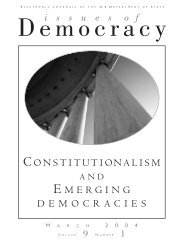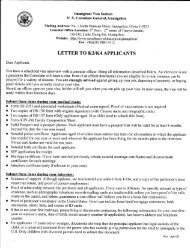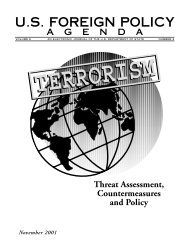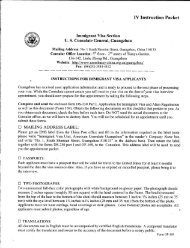s. history us history us history - Embassy of the United States
s. history us history us history - Embassy of the United States
s. history us history us history - Embassy of the United States
- No tags were found...
You also want an ePaper? Increase the reach of your titles
YUMPU automatically turns print PDFs into web optimized ePapers that Google loves.
CHAPTER 11: THE NEW DEAL AND WORLD WAR IIOUTLINE OF U.S. HISTORYWorld War II, isolationist sentimentincreased, even though Americansclearly favored <strong>the</strong> victims <strong>of</strong> Hitler’saggression and supported <strong>the</strong> Allieddemocracies, Britain and France.Roosevelt could only wait until publicopinion regarding U.S. involvementwas altered by events.After <strong>the</strong> fall <strong>of</strong> France and <strong>the</strong>beginning <strong>of</strong> <strong>the</strong> German air waragainst Britain in mid-1940, <strong>the</strong> debateintensified between those in <strong>the</strong><strong>United</strong> <strong>States</strong> who favored aiding <strong>the</strong>democracies and <strong>the</strong> antiwar factionknown as <strong>the</strong> isolationists. Rooseveltdid what he could to nudgepublic opinion toward intervention.The <strong>United</strong> <strong>States</strong> joined Canadain a Mutual Board <strong>of</strong> Defense, andaligned with <strong>the</strong> Latin American republicsin extending collective protectionto <strong>the</strong> nations in <strong>the</strong> WesternHemisphere.Congress, confronted with <strong>the</strong>mounting crisis, voted immensesums for rearmament, and in September1940 passed <strong>the</strong> first peacetimeconscription bill ever enactedin <strong>the</strong> <strong>United</strong> <strong>States</strong>. In that monthalso, Roosevelt concluded a daringexecutive agreement with BritishPrime Minister Winston Churchill.The <strong>United</strong> <strong>States</strong> gave <strong>the</strong> BritishNavy 50 “overage” destroyers in returnfor British air and naval basesin Newfoundland and <strong>the</strong> NorthAtlantic.The 1940 presidential electioncampaign demonstrated that <strong>the</strong>isolationists, while vocal, were aminority. Roosevelt’s Republicanopponent, Wendell Wilkie, leanedtoward intervention. Th<strong>us</strong> <strong>the</strong> Novemberelection yielded ano<strong>the</strong>rmajority for <strong>the</strong> president, makingRoosevelt <strong>the</strong> first, and last, U. S.chief executive to be elected to athird term.In early 1941, Roosevelt got Congressto approve <strong>the</strong> Lend-LeaseProgram, which enabled him totransfer arms and equipment toany nation (notably Great Britain,later <strong>the</strong> Soviet Union and China)deemed vital to <strong>the</strong> defense <strong>of</strong> <strong>the</strong><strong>United</strong> <strong>States</strong>. Total Lend-Lease aidby war’s end would amount to morethan $50,000 million.Most remarkably, in Aug<strong>us</strong>t, hemet with Prime Minister Churchill<strong>of</strong>f <strong>the</strong> coast <strong>of</strong> Newfoundland. Thetwo leaders issued a “joint statement<strong>of</strong> war aims,” which <strong>the</strong>ycalled <strong>the</strong> Atlantic Charter. Bearinga remarkable resemblance to WoodrowWilson’s Fourteen Points, itcalled for <strong>the</strong>se objectives: no territorialaggrandizement; no territorialchanges without <strong>the</strong> consent <strong>of</strong><strong>the</strong> people concerned; <strong>the</strong> right <strong>of</strong>all people to choose <strong>the</strong>ir own form<strong>of</strong> government; <strong>the</strong> restoration <strong>of</strong>self-government to those deprived<strong>of</strong> it; economic collaboration betweenall nations; freedom fromwar, from fear, and from want forall peoples; freedom <strong>of</strong> <strong>the</strong> seas;and <strong>the</strong> abandonment <strong>of</strong> <strong>the</strong> <strong>us</strong>e<strong>of</strong> force as an instrument <strong>of</strong> internationalpolicy.America was now neutral inname only.JAPAN, PEARL HARBOR,AND WARWhile most Americans anxio<strong>us</strong>lywatched <strong>the</strong> course <strong>of</strong> <strong>the</strong> Europeanwar, tension mounted in Asia. Takingadvantage <strong>of</strong> an opportunity toimprove its strategic position, Japanboldly announced a “new order” inwhich it would exercise hegemonyover all <strong>of</strong> <strong>the</strong> Pacific. Battling forsurvival against Nazi Germany, Britainwas unable to resist, abandoningits concession in Shanghai and temporarilyclosing <strong>the</strong> Chinese supplyroute from Burma. In <strong>the</strong> summer<strong>of</strong> 1940, Japan won permissionfrom <strong>the</strong> weak Vichy government inFrance to <strong>us</strong>e airfields in nor<strong>the</strong>rnIndochina (North Vietnam). ThatSeptember <strong>the</strong> Japanese formallyjoined <strong>the</strong> Rome-Berlin Axis. The<strong>United</strong> <strong>States</strong> countered with anembargo on <strong>the</strong> export <strong>of</strong> scrap ironto Japan.In July 1941 <strong>the</strong> Japanese occupiedsou<strong>the</strong>rn Indochina (SouthVietnam), signaling a probablemove southward toward <strong>the</strong> oil, tin,and rubber <strong>of</strong> British Malaya and<strong>the</strong> Dutch East Indies. The <strong>United</strong><strong>States</strong>, in response, froze Japaneseassets and initiated an embargo on<strong>the</strong> one commodity Japan neededabove all o<strong>the</strong>rs — oil.General Hideki Tojo becameprime minister <strong>of</strong> Japan that October.In mid-November, he sent aspecial envoy to <strong>the</strong> <strong>United</strong> <strong>States</strong>to meet with Secretary <strong>of</strong> StateCordell Hull. Among o<strong>the</strong>r things,Japan demanded that <strong>the</strong> <strong>United</strong><strong>States</strong> release Japanese assets andstop U.S. naval expansion in <strong>the</strong>Pacific. Hull countered with a proposalfor Japanese withdrawal fromall its conquests. The swift Japaneserejection on December 1 left <strong>the</strong>talks stalemated.On <strong>the</strong> morning <strong>of</strong> December 7,Japanese carrier-based planes executeda devastating surprise attackagainst <strong>the</strong> U.S. Pacific Fleet at PearlHarbor, Hawaii.Twenty-one ships were destroyedor temporarily disabled; 323 aircraftwere destroyed or damaged; 2,388soldiers, sailors, and civilians werekilled. However, <strong>the</strong> U.S. aircraftcarriers that would play such a criticalrole in <strong>the</strong> ensuing naval war in<strong>the</strong> Pacific were at sea and not anchoredat Pearl Harbor.American opinion, still dividedabout <strong>the</strong> war in Europe, was unifiedovernight by what PresidentRoosevelt called “a day that willlive in infamy.” On December 8,Congress declared a state <strong>of</strong> warwith Japan; three days later Germanyand Italy declared war on <strong>the</strong><strong>United</strong> <strong>States</strong>.MOBILIZATION FORTOTAL WARThe nation rapidly geared itself formobilization <strong>of</strong> its people and itsentire ind<strong>us</strong>trial capacity. Over <strong>the</strong>next three-and-a-half years, war ind<strong>us</strong>tryachieved staggering productiongoals — 300,000 aircraft, 5,000cargo ships, 60,000 landing craft,86,000 tanks. Women workers, ex-220221












